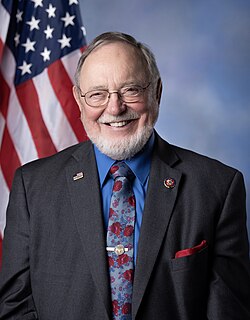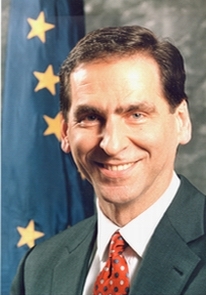Related Research Articles

Donald Edwin Young is an American politician and retired educator serving as the U.S. representative for Alaska's at-large congressional district since 1973. He is the Republican Party's longest-serving member of the House of Representatives and of Congress in history, having represented Alaska for 25 terms.

The Alaska Legislature is the state legislature of the U.S. state of Alaska. It is a bicameral institution consisting of the 40-member Alaska House of Representatives and the 20-member Alaska Senate. There are 40 House Districts (1–40) and 20 Senate Districts (A–T). With a total of 60 lawmakers, the Alaska Legislature is the smallest bicameral state legislature in the United States and the second-smallest of all state legislatures. There are no term limits for either chamber.

The North Carolina Council of State is the collective name for the senior executive offices in the Government of North Carolina, all of which are established by the Constitution of North Carolina. Currently, the Council of State includes the popularly elected Governor, Lieutenant Governor, Secretary of State, Auditor, Treasurer, Superintendent of Public Instruction, Attorney General, Commissioner of Agriculture, Commissioner of Labor and Commissioner of Insurance. In its current form, the Council of State meets periodically, with the Governor as chair, to allow for coordination and exchange of information across executive branch agencies and to vote on certain decisions, especially regarding the sale of government property or the borrowing of money.

Loren Dwight Leman is an American politician who served as lieutenant governor of Alaska, from 2002 to 2006. Before that, he served in both houses of the state legislature, and was elected as the Senate Majority Leader by the end of his term. He served in office in electoral politics from 1989 to 2006. When Leman was elected as lieutenant governor in 2002, he was the first person of Alaska Native ancestry to be elected to statewide office in Alaska. He also has Russian-Polish ancestry.
Political party strength in Alaska has varied over the years. The communities of Juneau, Sitka, downtown and midtown Anchorage, the areas surrounding the College/University of Alaska Fairbanks campus and Ester and the "Alaska Bush" – rural, sparsely populated Alaska – stand out as Democratic strongholds, while the Kenai Peninsula, Matanuska-Susitna Valley, parts of Anchorage, and Fairbanks, Ketchikan, Wrangell, and Petersburg serve as the Republican Party electoral base. As of 2021, over half of all registered voters have chosen "Non-Partisan" or "Undeclared" as their affiliation, despite recent attempts to close primaries.

Lesil Lynn McGuire is an American politician in the state of Alaska. She served as a Republican member of the Alaska Senate from 2007 until 2017, after her tenure as a member of the Alaska House of Representatives from 2000 through 2006. She served Senate District N until redistricting in 2012 placed her in District K for 2013.
Ralph Samuels is a businessman and a member of the Republican Party and candidate for Governor of Alaska, that served as a state representative of the Alaska State Legislature from 2002 to 2008 representing House District 29 and serving as the majority leader.
Donald William Stoltze was a Republican member of the Alaska Senate, representing District F. He was elected in 2014 after serving since 2003 as a member of the Alaska House of Representatives from the 16th District.

Bob Lynn was an American politician who served as a Republican member of the Alaska House of Representatives, representing the 31st district from 2003 to 2013 and the 26th district from 2013 to 2017. He served as Chair of the State Affairs Committee, was Vice-Chair of the Judiciary Committee, and was a member of the Transportation Committee and Joint Armed Forces Committees. He also served on the Labor & Workforce Development, Military & Veterans' Affairs, and Public Safety Finance Subcommittees, for the 28th Legislature. Bob Lynn is a retired fighter pilot with the United States Air Force and a Vietnam Veteran.
Alan David Austerman is an American politician who served as a member of the Alaska House of Representatives and Alaska Senate.
Charisse Millett is a Republican former member of the Alaska House of Representatives, representing the 25th District since 2008. In the 29th Legislature, from 2015 to 2016, she was the House Majority Leader. In the 30th Legislature, she served the House Minority Leader. She has also served as Co-Chair of the Energy Special Committee, and is a member of the Community & Regional Affairs Committee, Rules Committee, Fisheries Special Committee, and Armed Services Committee. She also serves on the Administration, Health & Social Services, and Transportation & Public Facilities Finance Subcommittees, for the 26th Legislature. Charisse Millett was a former Alaska State Legislative aide from 2005 to 2007 before being elected into office. In 2018, she was defeated in the Republican primary by Josh Revak.
Bob Herron is a Democratic former member of the Alaska House of Representatives, representing the 38th District from 2009 until 2017. Herron was the Majority Whip, granting him the distinction of being the only Representative in the United States elected as a Democrat who served as a statewide leader of a Republican party-majority legislative body. The official job of the Whip is to make sure that House members vote in line with Republican leadership.

Mark Neuman was a Republican member of the Alaska House of Representatives, representing the 15th District from 2005 to 2020. He served as Co-Chair of the Resources Committee, Vice-Chair of the Labor & Commerce Committee and the Rules Committee, Economic Development, Trade & Tourism Special Committee, the Cook Inlet Salmon Task Force, and the Legislative Budget & Audit Committee. He also served on the Commerce, Community & Economic Development, Corrections, Education & Early Development, and the Natural Resources Finance Subcommittee, for the 26th Legislature. Neuman is also a designer and builder of custom fine furniture.

Michael Patrick Kelly was a Republican member of the Alaska House of Representatives, representing the 7th District from 2005 until 2011. In the 26th Alaska State Legislature, he served on the Finance Committee, chairing the Corrections and the Natural Resources Finance Subcommittee. He also served on the Fish & Game Finance Subcommittee.
William A. Thomas Jr. is a businessman, commercial fisherman, and politician from the U.S. state of Alaska. Thomas served as a Republican member of the Alaska House of Representatives from the 5th District, comprising scattered rural and semi-rural communities throughout Southeast Alaska and stretching westward to Prince William Sound, from 2005 to 2013. Thomas served in the majority his entire tenure in the House and held multiple chairmanships. Thomas gained a seat on the powerful House Finance Committee during his second term and would eventually co-chair the committee. Following redistricting, Thomas lost reelection in 2012 by 32 votes to 23-year-old Jonathan Kreiss-Tomkins, a political newcomer who left Yale University to run.

Charles Michael Chenault is an American politician in the state of Alaska. Chenault served as a Republican member of the Alaska House of Representatives from 2001 to 2019, representing portions of the Kenai Peninsula Borough, where he has lived for most of his life. Chenault served as the body's speaker from 2009 to 2017. He lost his position as house speaker to Democrat Bryce Edgmon when three Republicans joined a coalition of Democrats to form a bipartisan house majority after the general election in November 2016.

John Bruce Coghill Jr. is a former Republican member of the Alaska Senate, representing North Pole and other communities in the Fairbanks North Star Borough. First elected to the Alaska House of Representatives in 1998, he was appointed to his Senate seat in 2009 and was the Senate's majority leader from 2013 to 2016. Since November 2018, he has been the Rules Committee chairman. In 2020, he lost re-election by 14 votes to fellow Republican Robert Myers Jr., who defeated him in the state's Republican primary election.
Nancy Dahlstrom is a former Republican member of the Alaska House of Representatives, representing the 18th district. She was appointed to the House at the beginning of the legislative session in 2003 when the representative-elect, Lisa Murkowski, was appointed to her father's U.S. Senate seat. Dahlstrom resigned her House seat to take a position in the administration of Governor Sean Parnell, then resigned from that position after less than a month when constitutional issues arose.
Carl J. Gatto was a Republican member of the Alaska House of Representatives, representing the 13th District since 2002. He served as Chair of the Military & Veterans' Affairs Special Committee, and was a member of the Judiciary Committee, State Affairs Committee, Administrative Regulation Review Committee and the Legislative Council. He also served on the Military & Veterans' Affairs, Natural Resources and the Revenue Finance Subcommittees, for the 26th Legislature. Before public office Carl Gatto was a paramedic and fire officer for the Anchorage Fire Department.
Craig W. Johnson is an American politician who served as a member of the Alaska House of Representatives from 2007 to 2017.
References
- ↑ "HSS.state.ak.us". HSS.state.ak.us. Retrieved 2014-08-19.
- ↑ Statewide Suicide Prevention Council. Mending the Net: Suicide Prevention in Alaska. 10 January 2011. p.4. Retrieved March 17, 2011.
- 1 2 3 Statewide Suicide Prevention Council. Mending the Net: Suicide Prevention in Alaska. 10 January 2011. p.4. Retrieved March 17, 2011
- ↑ "Codes.lp.findlaw.com". Codes.lp.findlaw.com. Retrieved 2014-08-19.
- 1 2 Statewide Suicide Prevention Council. Mending the Net: Suicide Prevention in Alaska. 10 January 2011. p.5. Retrieved March 17, 2011
- ↑ "Housemajority.org". Housemajority.org. Retrieved 2014-08-19.
- ↑ Statewide Suicide Prevention Council. Mending the Net: Suicide Prevention in Alaska. 10 January 2011. p.32. Retrieved March 17, 2011
- 1 2 Statewide Suicide Prevention Council. Mending the Net: Suicide Prevention in Alaska. 10 January 2011. p.33. Retrieved March 17, 2011
- ↑ HSS.state.ak.us Archived September 23, 2009, at the Wayback Machine